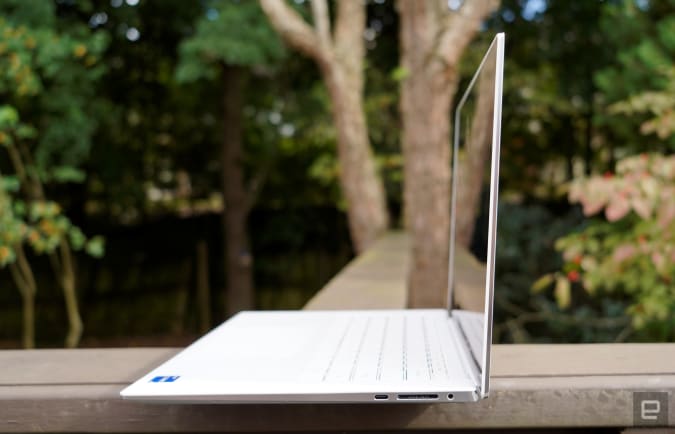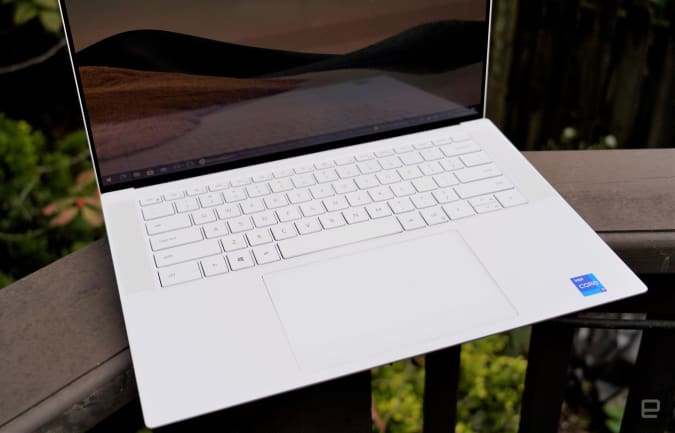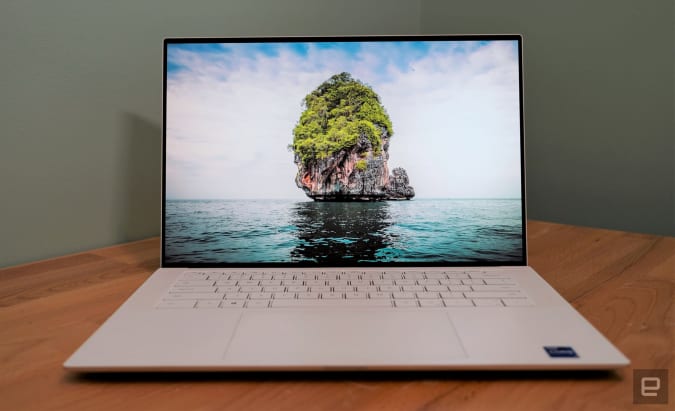Image Credit: Devindra Hardawar/Engadget
To push the XPS 15's display to the max, I turned to Ang Lee's Gemini Man, one of the few films viewable in 4K with HDR at 60 frames per second. Say what you will about the movie, but the OLED screen made the shootout between Will Smith and his younger clone feel almost as thrilling as watching it in theaters. Sure, it doesn't have a full 4K resolution, but that's not something you'll really notice while watching it. Another bonus: Dell's upward-firing speakers did a decent job throughout most of the action.
Outside of video, the XPS 15's OLED screen made looking at just about everything a joy. I've never had so much fun scrolling through text-heavy websites — even jotting ideas down in Evernote felt a bit more satisfying, thanks to the ultra crisp text. Photos just about popped off the screen, as you'd expect. The DCI-P3 color range is around 25 percent wider than the more common sRGB, which means images will be able to show off more depth.
The only way the XPS 15's screen could look better was if it took a cue from gaming laptops and offered a faster refresh rate. Going above 60Hz makes scrolling images and text look instantly smoother, but it'll likely be a few years before work-focused notebooks take advantage of that tech.
PCMark 10 | 3DMark Night Raid | ATTO disk speeds (top read/write) | |
Dell XPS 15 (Intel i7-11800H, NVIDIA RTX 3050 Ti 45w) | 5,966 | 22,264 | 2.8 GB/s / 2.6 GB/s |
Dell XPS 15 (Intel i7-10875H, NVIDIA GTX 1650 Ti) | 3,962 | 18,500 | 3 GB/s / 2.4 GB/s |
Surface Laptop 4 15" (AMD Ryzen 7 4980U Surface Edition, Radeon) | 4,620 | 15,517 | 1.9 GB/s / 985 MB/s |
ASUS ZenBook Duo (Intel Core i7-1165G7, Xe graphics) | 4,704 | 15,315 | 3.3 GB/s / 2.48 GB/s |
Our XPS 15 review unit was powered by an eight-core Intel i7-11800H, 16GB of RAM and a 45-watt version of NVIDIA's RTX 3050 Ti GPU. That's on the low-end of that GPU's potential power usage — it can go all the way up to 80 watts — which means it's far less capable than the same card in a gaming notebook. Still, it should be a huge upgrade from last year's GTX 1650 Ti. In the GPU-focused Geekbench 5 Compute benchmark, for example, the XPS 15 notched around 6,000 more points than last year's model.
I can't imagine too many people will be judging the XPS 15 on its gaming capabilities, not when you can get faster screens and potentially better hardware for similar prices from dedicated laptops. But if you're just itching to get a bit of Overwatch action in once in a while, it's good enough to reach 70fps in Overwatch at 2,560 by 1,600 (1,440p+) at the highest graphics settings. Honestly, it has enough power to tackle most modern games. Just don't try playing them at 3.5K.

Devindra Hardawar/Engadget
The XPS 15 also scored around 50 percent higher in the PCMark 10 benchmark, something I'd attribute both to that Intel CPU and the NVIDIA hardware. You can expect it to tackle most intense workloads with ease. It managed to transcode a one-minute 4K video file into 1080p in 35 seconds using Handbrake and the NVIDIA encoder.
As for the XPS 15's keyboard and trackpad, they're unchanged from last year. I appreciated the keyboard's wide layout and responsive keys, though I hope Dell explores ways to add even more depth. It'd be nice for some of that CherryMX technology from Alienware's gaming laptops to make its way to the XPS line. The trackpad, meanwhile, is luxuriously smooth. No complaints there.

Devindra Hardawar/Engadget
I'd like to see more than three USB-C ports, but at least two of them support Thunderbolt 4. And I'll always give a laptop extra credit for including a full-sized SD card slot. That's something photographers everywhere will appreciate. I was also surprised to find that the OLED screen didn't ding the XPS’s battery life as much as I thought it would. It lasted for nine hours and 55 minutes in our battery benchmark, compared to 10 hours and 10 minutes on last year's model with a 4K+ LCD.
The only downside of the XPS 15 is that Dell was a bit slow to add OLED. Remember, the company said OLED would be coming to the XPS 15 since CES 2019. I was surprised that Dell didn't include it in the XPS 15's redesign last year and I wager the pandemic slowed things down a bit. But other PC makers, like ASUS, were much quicker to build OLED laptops, so it’s hard to make excuses for Dell.

Devindra Hardawar/Engadget
The new XPS 15 starts at $1,300 with a Core i5 processor, integrated graphics, 8GB of RAM and a 256GB SSD. You'd have to shell out $2,000 to nab our review unit with a 512GB SSD. Those are reasonable prices for 15-inch workhorse machines, especially when the 16-inch MacBook Pro is a rather painful $2,400 and still has an aging ninth-gen Intel chip.
Honestly, I didn't expect Dell to do much with the XPS 15 after last year. But the addition of OLED goes a long way. It's one of the best screens you can find on a laptop today. It's so good, in fact, that it makes the XPS 15 almost perfect.
All products recommended by Engadget are selected by our editorial team, independent of our parent company. Some of our stories include affiliate links. If you buy something through one of these links, we may earn an affiliate commission.
















